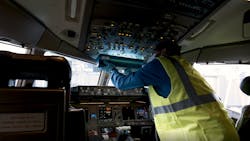United Airlines has announced that it has begun using a germicidal ultraviolet (UV) disinfection process to clean the flight deck of its aircraft, including the many switches, touchscreens, and other surfaces that flight crews regularly touch. The airline said it consulted with the Cleveland Clinic in developing the UV-C band (100–280 nm) disinfection process that relies on airline workers using handheld fixtures near surfaces, displays, and switches. The airline has continued for now to clean its aircraft cabins with an electrostatic spraying of disinfectant.
We just recently published a blog post covering JetBlue and that airline’s use of robots with extensible UV-C arms to disinfect cabins, including the presumed capability of deactivating coronavirus. The aircraft cabin would naturally be a primary area for germicidal measures given the potential of having asymptomatic COVID-19-afflicted passengers in the cabin and having to safely transport large number of passengers. An airline would have much tighter access control to the flight deck. Still, we didn’t consider the difficulties the flight deck environment presents with nooks and crannies galore surrounding switches, displays, and controls.
“Flight decks have many working parts, screens, and components that are challenging to clean with traditional hand wipes and liquids, especially for someone who isn’t a pilot,” said Bryan Quigley, United’s senior vice president of flight operations. “The UV-C lighting gives us a faster, more effective disinfection of one of the most important areas of the aircraft.”
The United process, however, does use the aforementioned handheld fixtures. We’ve repeatedly warned of the potential for handheld UV-C products to damage human eyes and skin and some companies that are promoting dangerous products and usage scenarios. Moreover, a number of leading industry organizations have warned against some UV-C usage scenarios.
In the United case, we’d surmise that the Cleveland Clinic completely evaluated the safety of the flight-deck cleaning process. That clinic is an academic medical institution with an outstanding reputation. “United implementing UV-C lighting in its flight decks is an important tactic because we know that the virus can be killed by ultraviolet light,” said Dr. James Merlino, chief clinical transformation officer at the Cleveland Clinic. “It’s one more measure that we can implement to ensure that we’re doing all we can to keep passengers, flight attendants, and crews safer.”
The video of the process that United has posted, however, does show some potential for UV-C exposure, although we frankly don’t have the credentials to discern whether there might be issues with the process. The airline worker in the video does appear to have protective clothing over the arm areas and facial/eye protection. And there are plenty of materials that can block UV-C emission. But the back of the worker’s head is exposed.
Now we know from our UV-C webcast held back in June that UV-C emission does not reflect from surfaces in the same manner that visible light does. So it could be unlikely that a worker cleaning a flight deck would have an exposure danger. And we assume the aircraft windshield would block UV-C emission from escaping the cockpit. Mishandling the handheld unit, however, could lead to exposure.
United said that the product being used for the cleaning is the AUVCo blade from American Ultraviolet. That company has a long history working with UV and is certainly not a newcomer trying to capitalize on the pandemic. And the company has posted a long list of UV-C information resources on its website.
The usage scenario in the flight deck did reveal some other interesting tidbits. We discussed the UV-C power and duration needed to deactivate the coronavirus in another recent news article on an air disinfection system developed by Energy Harness. The task at hand must be analyzed to arrive at the dosage required for germicidal efficacy. Watching the United video, it’s clear that the worker has been instructed as to how long the UV-C beam must be applied to each section of the controls and surfaces. American Ultraviolet says that its product delivers 735 µW/cm2 of energy at 6 in. from the surface. The dosage would be that intensity multiplied by exposure time.
For up-to-the-minute LED and SSL updates, why not follow us on Twitter? You’ll find curated content and commentary, as well as information on industry events, webcasts, and surveys on our LinkedIn Company Page and our Facebook page.





